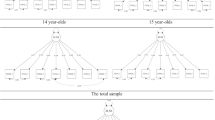Abstract
The aim of the present study was to provide further support for the validity of the Brief Multidimensional Students’ Life Satisfaction Scale (BMSLSS), using a sample of 1904 Chinese elementary school students (Grades 4–6). Toward this aim, we first performed item analysis and factor analyses to investigate the structure of the BMSLSS. Second, we examined its internal consistency reliability, convergent and discriminant validity, test-retest reliability and predictive validity. Last, we tested its measurement invariance across gender using multi-group analysis. The results provided preliminary evidence for the reliability and validity of the BMSLSS in assessing Chinese elementary school students’ life satisfaction. The potential applications of the BMSLSS for future research were discussed.

Similar content being viewed by others
References
Abedi, M. R., & Vostanis, P. (2010). Evaluation of quality of life therapy for parents of children with obsessive–compulsive disorders in Iran. European Child & Adolescent Psychiatry, 19(7), 605–613. doi:10.1007/s00787-010-0098-4.
Adelman, H. S., Taylor, L., & Nelson, P. (1989). Minors’ dissatisfaction with their life circumstances. Child Psychiatry and Human Development, 20(2), 135–147. doi:10.1007/BF00711660.
Ash, C., & Huebner, E. S. (2001). Environmental events and life satisfaction reports of adolescents: a test of cognitive mediation. School Psychology International, 22(3), 320–336. doi:10.1177/0143034301223008.
Bender, T. A. (1997). Assessment of subjective well-being during childhood and adolescence. In G. Phye (Ed.), Handbook of classroom assessment: Learning, achievement, and adjustment (pp. 195–225). San Diego: Academic.
Bollen, K. A. (1989). Structural equations with latent variables. New York: Wiley.
Bradley, R., & Corwyn, R. (2004). Life satisfaction among European American, African American, Chinese American, Mexican American, and Dominican American adolescents. International Journal of Behavioral Development, 28(5), 385–400. doi:10.1080/01650250444000072.
Campbell, H. L., Barry, C. L., Joe, J. N., & Finney, S. J. (2008). Configural, metric, and scalar invariance of the modified achievement goal questionnaire across African American and white university students. Educational and Psychological Measurement, 68(6), 998–1007. doi:10.1177/0013164408315269.
Casas, F., Sarriera, J. C., Alfaro, J., González, M., Bedin, L., Abs, D., & Valdenegro, B. (2014). Reconsidering life domains that contribute to subjective well-being among adolescents with data from three countries. Journal of Happiness Studies. doi:10.1007/s10902-014-9520-9.
Cordon, S. L., & Finney, S. J. (2008). Measurement invariance of the mindful attention awareness scale across adult attachment style. Measurement and Evaluation in Counseling and Development, 40(4), 228–245.
Corwyn, R. F. (2000). The factor structure of global self-esteem among adolescents and adults. Journal of Research in Personality, 34(4), 357–379. doi:10.1006/jrpe.2000.2291.
Cummins, R. (1997). Manual for the comprehensive quality of life scale-student (Grades 7–12): ComQol-S5. Melbourne: Deakin University.
Dew, T., & Huebner, E. S. (1994). Adolescents’ perceived quality of life: an exploratory investigation. Journal of School Psychology, 32(2), 185–199. doi:10.1016/0022-4405(94)90010-8.
Diener, E., Suh, E. M., Lucas, R. E., & Smith, H. L. (1999). Subjective well-being: three decades of progress. Psychological Bulletin, 125(2), 276–302. doi:10.1037/0033-2909.125.2.276.
Fogle, L. M., Scott Huebner, E., & Laughlin, J. E. (2002). The relationship between temperament and life satisfaction in early adolescence: Cognitive and behavioral mediation models. Journal of Happiness Studies, 3(4), 373–392. doi:10.1023/A:1021883830847.
Funk, B. A., Huebner, E. S., & Valois, R. F. (2006). Reliability and validity of a brief life satisfaction scale with a high school sample. Journal of Happiness Studies, 7(1), 41–54. doi:10.1007/s10902-005-0869-7.
Furr, R. M., & Funder, D. C. (1998). A multimodal analysis of personal negativity. Journal of Personality and Social Psychology, 74(6), 1580–1591. doi:10.1037/0022-3514.74.6.1580.
Gilligan, T. D., & Huebner, E. S. (2002). Multidimensional life satisfaction reports of adolescents: a multitrait-multimethod study. Personality and Individual Differences, 32(7), 1149–1155. doi:10.1016/S0191-8869(00)00196-3.
Gilman, R., & Huebner, E. S. (2000). Review of life satisfaction measures for adolescents. Behaviour Change, 17(3), 178–195. doi:10.1375/bech.17.3.178.
Gilman, R., & Huebner, S. (2003). A review of life satisfaction research with children and adolescents. School Psychology Quarterly, 18(2), 192–205. doi:10.1521/scpq.18.2.192.21858.
Gilman, R., & Huebner, E. S. (2006). Characteristics of adolescents who report very high life satisfaction. Journal of Youth and Adolescence, 35(3), 293–301. doi:10.1007/s10964-006-9036-7.
Gilman, R., Huebner, E. S., & Funk, B. A. (2000a). Cross-sectional and longitudinal psychosocial correlates of adolescent life satisfaction reports. Canadian Journal of School Psychology, 16(1), 53–64. doi:10.1177/082957350001600104.
Gilman, R., Huebner, S., & Laughlin, J. E. (2000b). A first study of the multidimensional Students’ life satisfaction scale with adolescents. Social Indicators Research, 52(2), 135–160. doi:10.1023/A:1007059227507.
Greenspoon, P. J., & Saklofske, D. H. (1997). Validity and reliability of the multidimensional Students’ life satisfaction scale with Canadian children. Journal of Psychoeducational Assessment, 15(2), 138–155. doi:10.1177/073428299701500204.
Haranin, E. C., Huebner, E. S., & Suldo, S. M. (2007). Predictive and incremental validity of global and domain-based adolescent life satisfaction reports. Journal of Psychoeducational Assessment, 25(2), 127–138. doi:10.1177/0734282906295620.
Headey, B., Veenhoven, R., & Wearing, A. (1991). Top-down versus bottom-up theories of subjective well-being. Social Indicators Research, 24(1), 81–100. doi:10.1007/BF00292652.
Hou, J., Zou, H., & LI, X. (2009). The characteristics of the family environment and its influence on the life satisfaction of migrant children. Psychological Development and Education, 2(40), 78–85.
Hu, L., & Bentler, P. M. (1999). Cutoff criteria for fit indexes in covariance structure analysis: conventional criteria versus new alternatives. Structural Equation Modeling: A Multidisciplinary Journal, 6(1), 1–55. doi:10.1080/10705519909540118.
Huebner, E. S. (1991a). Initial development of the Student’s life satisfaction scale. School Psychology International, 12(3), 231–240. doi:10.1177/0143034391123010.
Huebner, E. S. (1991b). Correlates of life satisfaction in children. School Psychology Quarterly, 6(2), 103–111. doi:10.1037/h0088805.
Huebner, E. S. (1994a). Preliminary development and validation of a multidimensional life satisfaction scale for children. Psychological Assessment, 6(2), 149–158. doi:10.1037/1040-3590.6.2.149.
Huebner, E. S. (1994b). Conjoint analyses of the Students’ life satisfaction scale and the Piers-Harris self-concept scale. Psychology in the Schools, 31(4), 273–277.
Huebner, E. S. (2004). Research on assessment of life satisfaction of children and adolescents. Social Indicators Research, 23, 3–33. doi:10.1007/978-1-4020-2312-5_2.
Huebner, E. S., Gilman, R., & Laughlin, J. E. (1999). A multimethod investigation of the multidimensionality of children’s well-being reports: discriminant validity of life satisfaction and self-esteem. Social Indicators Research, 46(1), 1–22. doi:10.1023/A:1006821510832.
Huebner, E. S., Funk, B. A., & Gilman, R. (2000). Cross-sectional and longitudinal psychosocial correlates of adolescent life satisfaction reports. Canadian Journal of School Psychology, 16(1), 53–64. doi:10.1177/082957350001600104.
Huebner, E. S., Gilman, R., & Suldo, S. M. (2007). Assessing perceived quality of life in children and youth. Mahwah: Lawrence Erlbaum Associates Publishers.
Irmak, S., & Kuruüzüm, A. (2008). Turkish validity examination of the multidimensional students’ life satisfaction scale. Social Indicators Research, 92(1), 13–23. doi:10.1007/s11205-008-9284-x.
Jöreskog, K. G., & Sörbom, D. (1996). LISREL 8: User’s reference guide. Chicago: Scientific Software International.
Kline, R. B. (1998). Principles and practice of structural equation modeling. New York: Guilford Press.
Kline, R. B. (2005). Principles and practice of structural equation modeling (2nd ed.). New York, NY: The Guilford Press.
Kong, F., Zhao, J., & You, X. (2012). Self-esteem as mediator and moderator of the relationship between social support and subjective well-being among Chinese university students. Social Indicators Research, 112(1), 151–161. doi:10.1007/s11205-012-0044-6.
Kwan, Y.-K. (2007). Life satisfaction and family structure among adolescents in Hong Kong. Social Indicators Research, 86(1), 59–67. doi:10.1007/s11205-007-9092-8.
Lance, C. E., Lautenschiager, G. J., et al. (1989). A comparison between bottom-up, top-down, and bidirectional models of relationships between global and life facet satisfaction. Journal of Personality, 57(3), 601–624.
Little, T. D. (1997). Mean and covariance structures (MACS) analyses of cross-cultural data: practical and theoretical issues. Multivariate Behavioral Research, 32(1), 53–76. doi:10.1207/s15327906mbr3201_3.
Liu, W., Tian, L., Scott Huebner, E., Zheng, X., & Li, Z. (2014). Preliminary development of the elementary school students’ subjective well-being in school scale. Social Indicators Research. doi:10.1007/s11205-014-0614-x.
Long, R. F., & Huebner, E. S. (2014). Differential validity of global and domain-specific measures of life satisfaction in the context of schooling. Child Indicators Research, 7(3), 671–694. doi:10.1007/s12187-013-9231-5.
Lyubomirsky, S., King, L., & Diener, E. (2005). The benefits of frequent positive affect: does happiness lead to success? Psychological Bulletin, 131(6), 803–855. doi:10.1037/0033-2909.131.6.803.
Marquardt, D. W. (1970). Generalized inverses, ridge regression, biased linear estimation, and nonlinear estimation. Technometrics, 12, 591–256.
McCullough, M. E., & Snyder, C. R. (2000). Classical sources of human strength: revisiting an old home and building a new one. Journal of Social and Clinical Psychology, 19(1), 1–10. doi:10.1521/jscp.2000.19.1.1.
McKnight, C. G., Huebner, E. S., & Suldo, S. (2002). Relationships among stressful life events, temperament, problem behavior, and global life satisfaction in adolescents. Psychology in the Schools, 39(6), 677–687. doi:10.1002/pits.10062.
Park, N., & Huebner, E. S. (2005). A cross-cultural study of the levels and correlates of life satisfaction among adolescents. Journal of Cross-Cultural Psychology, 36(4), 444–456. doi:10.1177/0022022105275961.
Park, N., Huebner, E. S., Laughlin, J. E., Valois, R. F., & Gilman, R. (2004). A cross-cultural comparison of the dimensions of child and adolescent life satisfaction reports. Social Indicators Research, 23, 61–79. doi:10.1007/978-1-4020-2312-5_4.
Proctor, C. L., Linley, P. A., & Maltby, J. (2009). Youth life satisfaction: a review of the literature. Journal of Happiness Studies, 10(5), 583–630. doi:10.1007/s10902-008-9110-9.
Raphael, D., Rukholm, E., Brown, I., & Hill-Bailey, P. (1996). The quality of life profile-adolescent version: background, description, and initial validation. Journal of Adolescent Health, 19(5), 366–375. doi:10.1016/S1054-139X(96)00080-8.
Rensvold, R. B., & Cheung, G. W. (2001). Testing for metric invariance using structural equation models: solving the standardization problem. Research in Management, 1, 21–50.
Rosenberg, M. (1965). Society and the adolescent self-image. Princeton: Princeton University Press.
Saris, W. E. (1982). Different questions, different variables. In C. Fornell (Ed.), A second generation of multivariate analysis (Vol. 2, pp. 78–95). New York: Praeger.
Seligman, M. E. P., & Csikszentmihalyi, M. (2000). Positive psychology: an introduction. American Psychologist, 55(1), 5–14. doi:10.1037//0003-066x.55.1.5.
Seligson, J. L., Huebner, E. S., & Valois, R. F. (2003). Preliminary validation of the Brief Multidimensional Students’ Life Satisfaction Scale (BMSLSS). Social Indicators Research, 61(2), 121–145. doi:10.1023/A:1021326822957.
Seligson, J. L., Huebner, E. S., & Valois, R. F. (2005). An investigation of a brief life satisfaction scale with elementary school children. Social Indicators Research, 73(3), 355–374. doi:10.1007/s11205-004-2011-3.
Siyez, D. M., & Kaya, A. (2007). Validity and reliability of the Brief Multidimensional Students’ Life Satisfaction Scale with Turkish children. Journal of Psychoeducational Assessment, 26(2), 139–147. doi:10.1177/0734282907307802.
Steenkamp, J.-B. E., & Baumgartner, H. (1998). Assessing measurement invariance in cross-national consumer research. Journal of Consumer Research, 25(1), 78–107. doi:10.1086/209528.
Suldo, S. M., & Huebner, E. S. (2005). Is extremely high life satisfaction during adolescence advantageous? Social Indicators Research, 78(2), 179–203. doi:10.1007/s11205-005-8208-2.
Terry, T., & Huebner, E. S. (1995). The relationship between self-concept and life satisfaction in children. Social Indicators Research, 35(1), 39–52. doi:10.1007/BF01079237.
Tian, L., & Liu, W. (2005). Test of the Chinese version of multidimensional students’ life satisfaction scale. Chinese Journal of Mental Health, 19(5), 301–303.
Tian, L., Liu, B., Huang, S., & Huebner, E. S. (2012). Perceived social support and school well-being among Chinese early and middle adolescents: the mediational role of self-esteem. Social Indicators Research, 113(3), 991–1008. doi:10.1007/s11205-012-0123-8.
Valois, R. F., Zullig, K., Huebner, E. S., & Drane, J. W. (2001). Relationship between life satisfaction and violent behaviors among adolescents. American Journal of Health Behavior, 25(4), 353–366. doi:10.5993/AJHB.25.4.1.
Valois, R. F., Zullig, K. J., Huebner, E. S., Kammermann, S. K., & Drane, J. W. (2002). Association between life satisfaction and sexual risk-taking behaviors among adolescents. Journal of Child and Family Studies, 11(4), 427–440. doi:10.1023/A:1020931324426.
Vandenberg, R. J., & Lance, C. E. (2000). A review and synthesis of the measurement invariance literature: suggestions, practices, and recommendations for organizational research. Organizational Research Methods, 3(1), 4–70. doi:10.1177/109442810031002.
Wang, R., & Zou, H. (2008). The influencing effect of personality to immigrant children’s subjective well-being. Psychological Exploration, 28(3), 82–87.
Wang, M., Cai, B., Wu, Y., & Dai, X. (2010). The factor structure of Chinese Rosenberg self-esteem scale affected by item statement method. Psychological Exploration, 30(3), 63–68.
Yan, B., & Zheng, X. (2008). A test of cultural effects on the relationship between college students’ life satisfaction and subjective well-being. Psychological Science, 30(6), 1337–1341.
Ye, M., Li, L., Li, Y., Shen, R., Wen, S., & Zhang, J. (2013). Life satisfaction of adolescents in Hunan, China: reliability and validity of Chinese Brief Multidimensional Students’ Life Satisfaction Scale (BMSLSS). Social Indicators Research, 118(2), 515–522. doi:10.1007/s11205-013-0438-0.
Zullig, K. J., Valois, R. F., Huebner, E. S., Oeltmann, J. E., & Drane, J. W. (2001). Relationship between perceived life satisfaction and adolescents’ substance abuse. Journal of Adolescent Health, 29(4), 279–288. doi:10.1016/S1054-139X(01)00269-5.
Acknowledgments
This research was supported by the Project of Key Research Base for Humanities and Social Sciences Research of Ordinary Higher Institutions in Guangdong Province (No. 11JDXM19001) and “12th Five-Year” Plan of Philosophy and Social Science Development in Guangzhou City (No. 11Y24). This study was also supported by Key Laboratory of Mental Health and Cognitive Science of Guangdong Province, South China Normal University, and Research Center for Crisis Intervention and Psychological Service of Guangdong Province, South China Normal University. We gratefully acknowledge the reviewers for their very helpful comments and suggestions.
Author information
Authors and Affiliations
Corresponding author
Rights and permissions
About this article
Cite this article
Tian, L., Zhang, J. & Huebner, E.S. Preliminary Validation of the Brief Multidimensional Students’ Life Satisfaction Scale (BMSLSS) Among Chinese Elementary School Students. Child Ind Res 8, 907–923 (2015). https://doi.org/10.1007/s12187-014-9295-x
Accepted:
Published:
Issue Date:
DOI: https://doi.org/10.1007/s12187-014-9295-x




